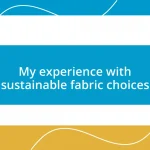Key takeaways:
- A fashion portfolio acts as a visual resume, showcasing not only skills but also the designer’s unique style, narrative, and emotional connection to their work.
- Identifying your unique style through reflection, analysis, experimentation, and feedback is essential for creating an authentic and resonant portfolio.
- Utilizing digital platforms effectively and engaging in consistent storytelling can significantly enhance the visibility and impact of your fashion portfolio.

Understanding Fashion Portfolio Purpose
A fashion portfolio serves as a visual resume, showcasing not just your work but your unique style and perspective. I remember when I first started building mine; it felt like I was assembling pieces of my creative identity, each photo telling a story. Isn’t it incredible how a single image can convey a designer’s ethos or provoke an emotional response?
The purpose of a fashion portfolio goes beyond mere presentation; it’s about crafting a narrative that resonates with the viewer. I often reflect on the projects that ignited my passion for design—those moments became focal points in my portfolio. How can your work reflect not just skill, but a genuine connection to your inspirations?
Ultimately, a well-curated fashion portfolio opens doors to opportunities and conversations. Each project included evokes a different feeling, reminding me of the times I challenged myself creatively. Have you ever felt that rush when a piece truly represents you? That’s the magic you want your portfolio to convey.

Identifying Your Unique Style
Identifying your unique style is a crucial step in building a fashion portfolio that stands out. I still remember the moment I found my signature aesthetic—it was like discovering a hidden part of myself. It all happened during a vibrant street fashion week when I observed how certain colors and textures lit up my spirit. The realization that each outfit I loved echoed my personality was both empowering and liberating.
To help you pinpoint your distinct style, consider the following points:
- Reflect on Your Inspirations: Think about the artists, designers, and trends that inspire you. What elements do you find yourself drawn to?
- Analyze Your Wardrobe: Look at the pieces you gravitate towards. Are there common colors, cuts, or patterns?
- Experiment Fearlessly: Don’t hesitate to try varying styles. Sometimes you can only find your true voice by mixing and matching.
- Keep a Visual Diary: Collect images from magazines, social media, or your own photographs that resonate with you—this will help you visualize your style.
- Seek Feedback: Sometimes, outsiders can see what we miss. Ask friends or mentors what they perceive as your style.
Understanding these aspects can help streamline your design process, allowing your portfolio to resonate more authentically with potential clients or collaborators.

Gathering Essential Portfolio Elements
Gathering the essential elements for a fashion portfolio is an exciting yet vital phase. I remember diving headfirst into my collection of work, curating pieces that not only defined my skills but also encapsulated moments of genuine joy and exploration. When assembling my portfolio, I realized that each element should represent a milestone in my journey—every design, project, and collaboration had its own story to tell. What about you? Have you identified the pieces that mark your creative evolution?
In putting together my portfolio, I focused on variety yet cohesion. Including a mix of sketches, finished products, and mood boards helped showcase the breadth of my work. It’s important to balance showcasing your technical abilities with your creative vision. This is where I like to include collaborative pieces too; they highlight my ability to adapt and work with others while maintaining my unique voice. I often ask myself: Does this piece reflect who I am as a designer? If the answer is yes, then it deserves a spot!
Furthermore, presentation plays a pivotal role. I learned that organizing my portfolio in a visually friendly manner creates an inviting experience for its viewers. Using a clean layout with thoughtful separation between sections not only aids in clarity but also allows each piece to shine in its own right. Have you considered how arrangement impacts perception? A well-structured portfolio can leave a lasting impression on clients or employers who view it.
| Portfolio Element | Description |
|---|---|
| Sketches | Showcases initial concepts and design evolution. |
| Finished Products | Displays completed designs reflecting craftsmanship. |
| Mood Boards | Illustrates inspiration and color palette choices. |
| Collaborative Projects | Demonstrates teamwork and adaptability. |

Selecting Effective Presentation Formats
Selecting the right presentation format for your fashion portfolio is essential, as it influences how your work is perceived. I vividly recall the first time I showcased my designs online; the thrill of seeing my creations neatly laid out in a digital format was both exhilarating and daunting. I experimented with a grid layout, which allowed me to display multiple pieces simultaneously, giving viewers a comprehensive look at my aesthetic while encouraging them to explore individual projects even further.
When considering formats, think about your target audience and the message you wish to convey. For instance, I found that using a storytelling format worked wonders for my collections. It wasn’t just about the designs; it was about illustrating the journey behind each piece. Have you ever thought about how a narrative can deeply connect with your audience? Capturing the inspiration, the creative process, and even the challenges I faced added depth and engaged viewers on a more personal level.
Another aspect I’ve learned is the power of physical presentations, such as lookbooks or mood board displays. I remember feeling a surge of pride as I held my first printed lookbook, filled with glossy images that brought my work to life. The tactile experience couldn’t be replicated online and sparked a different kind of engagement. What formats excite you the most? Whether it’s digital or print, choosing the right presentation can transform your portfolio from a simple collection of work into a true showcase of your creative identity.

Building a Cohesive Narrative
While building a cohesive narrative for my fashion portfolio, I’ve learned that telling a compelling story is just as crucial as showcasing my designs. Each piece in my collection serves as a chapter, revealing my creative journey and evolution. I often find myself reflecting on moments that inspired my work—like that spontaneous trip to Paris, where the street style ignited a whole new direction in my designs. Have you ever thought about how places shape your creative narrative?
I believe a powerful narrative creates connections with viewers, engaging them on a deeper level. I still remember the first time a potential client shared how my aesthetic resonated with their vision—they connected the dots of my story, weaving together my inspirations and aspirations. It reinforced for me how vital it is to weave personal anecdotes throughout my portfolio. How can you incorporate parts of your life experiences to enhance your story?
Lastly, I focus on the sequence of my portfolio elements to guide the viewer through my narrative seamlessly. By thoughtfully arranging projects in chronological or thematic order, I create a flow that captivates attention from start to finish. I often think about this arrangement as a playlist—each piece has its own vibe, yet together they create a harmonious experience. What’s your strategy for ensuring your story unfolds in a way that resonates?

Utilizing Digital Platforms
Utilizing digital platforms has transformed how I share my fashion portfolio, enabling me to reach a global audience without geographical limitations. I recall the excitement of setting up my first Instagram account dedicated to my designs. Every post was an opportunity to not only showcase my work but also connect with fellow creatives who inspired me. Have you thought about the power of social media in building your visibility? It’s astonishing how a single hashtag can lead to meaningful interactions and collaborations.
As I navigated different digital platforms, I discovered the importance of tailored content. For example, while Instagram focuses heavily on visuals and aesthetics, platforms like Pinterest allow for more in-depth exploration of ideas. I remember curating a Pinterest board that encapsulated the mood of my latest collection. It became a visual diary of inspiration, drawing in potential clients and collaborators. How might you use various platforms to reflect different facets of your creative journey?
Additionally, I’ve found that having a professional website serves as the cornerstone of my online presence. It not only showcases my portfolio but also includes my design philosophy and contact information. Building my website was one of the most rewarding experiences; I felt it solidified my identity as a designer. Every detail, from the color scheme to the layout, was meticulously crafted to reflect my brand. How does your online presence represent who you are as a designer? This thoughtful approach can turn a simple portfolio into an engaging and memorable experience for visitors.

Promoting Your Fashion Portfolio
Promoting my fashion portfolio effectively is all about creating engaging content and sparking conversations. I remember sharing a behind-the-scenes video of my design process on Instagram Stories, and the response was astonishing. People were not just liking the post; they were asking questions about my inspirations and techniques. This interaction helped me realize that showcasing the journey, not just the final product, can draw people into my world. Have you ever thought about how sharing your process could deepen your audience’s connection to your work?
Networking has also played a crucial role in promoting my portfolio. I vividly recall attending a local fashion event where I handed out business cards with a link to my portfolio. Engaging in conversations with other designers and potential collaborators that night opened doors I hadn’t even considered. Those shared moments, whether it’s laughing over a styling mishap or discussing fabric choices, ultimately created a community around my work. So, how do you foster relationships that can amplify your visibility?
Lastly, I can’t stress enough the impact of consistent storytelling. Each season, I create themed content that ties new collections back to my overall narrative, allowing my audience to see growth and evolution in real time. Recently, I launched a collection inspired by sustainable practices, and I paired that with posts highlighting my journey towards eco-conscious design. The engagement I received was powerful, reinforcing how authenticity resonates. Have you explored how the themes in your portfolio can drive consistent conversations with your audience?














